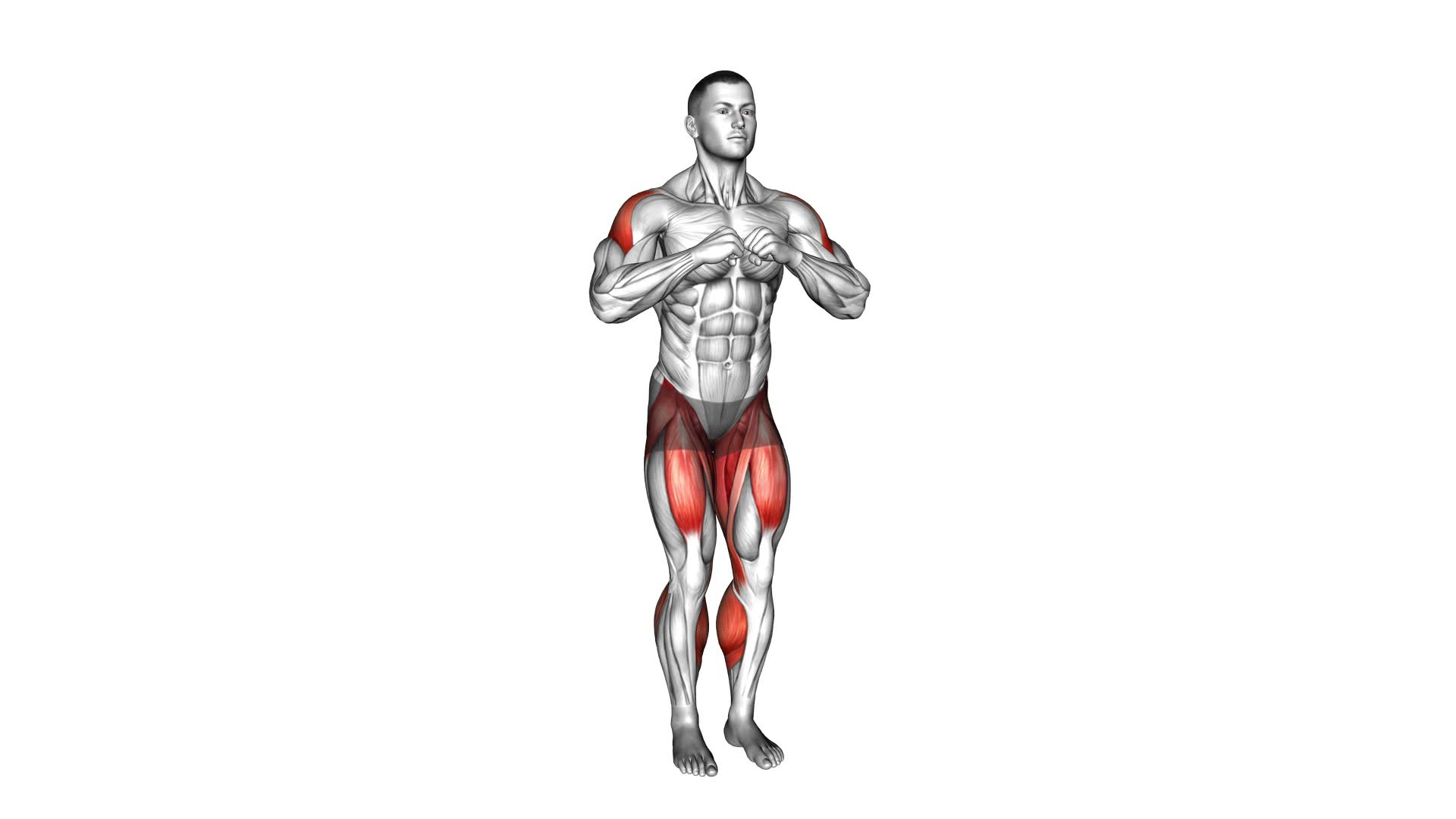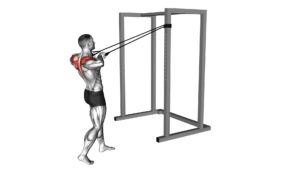Side Step Rear Delt Row – Video Exercise Guide & Tips

Are you looking for an effective exercise to target your rear deltoids? Look no further than the Side Step Rear Delt Row.
Watch This Exercise Video
This video exercise guide and tips will show you the proper form and variations of this exercise to help you maximize its effectiveness.
Avoid common mistakes and get the most out of your workout with this informative guide.
Get ready to strengthen and tone your rear delts like never before!
Key Takeaways
- Improved shoulder strength and stability
- Targets rear deltoids for proper posture and injury prevention
- Engages multiple muscle groups simultaneously
- Use resistance bands instead of dumbbells for greater range of motion and muscle imbalance correction
Benefits of the Side Step Rear Delt Row
You'll experience improved shoulder strength and stability by incorporating the Side Step Rear Delt Row into your workout routine. This exercise specifically targets the rear deltoids, which are important for maintaining proper posture and preventing shoulder injuries. By strengthening these muscles, you can enhance your overall upper body strength and reduce the risk of imbalances.
One of the key benefits of the Side Step Rear Delt Row is that it engages multiple muscle groups simultaneously. In addition to the rear deltoids, this exercise also works the muscles in your upper back, including the rhomboids and trapezius. This not only helps to improve your posture, but also enhances your overall upper body strength and stability.
Another benefit of the Side Step Rear Delt Row is that it can be easily modified to suit your fitness level and goals. You can adjust the resistance by using different weights or resistance bands. Additionally, you can vary the movement by performing the exercise standing or seated, using dumbbells or a cable machine. These variations allow you to continually challenge your muscles and prevent plateaus in your training.
Incorporating the Side Step Rear Delt Row into your workout routine can lead to improved shoulder strength, stability, and posture. With its ability to engage multiple muscle groups and its various modifications, this exercise is a valuable addition to any upper body workout.
Proper Form for the Side Step Rear Delt Row
To perform the Side Step Rear Delt Row with proper form, focus on maintaining a strong and stable posture throughout the exercise. This exercise primarily targets the rear deltoids, which are the muscles located at the back of your shoulders. In addition to the rear deltoids, it also works the upper back muscles, including the rhomboids and trapezius.
To incorporate the Side Step Rear Delt Row into your workout routine, start by standing with your feet hip-width apart and a dumbbell in each hand. Take a step to the side with one foot, maintaining a slight bend in your knees. Keep your back straight, chest up, and core engaged.
Next, hinge forward at the hips while keeping your spine neutral. Allow your arms to hang straight down towards the floor with your palms facing each other. This is your starting position.
From here, squeeze your shoulder blades together and lift the dumbbells out to the sides, leading with your elbows. Keep your arms close to your body and avoid shrugging your shoulders. Pause at the top of the movement, then slowly lower the dumbbells back to the starting position.
Incorporate the Side Step Rear Delt Row into your upper body or back workout routine, performing 3 sets of 8-12 repetitions. Remember to start with lighter weights and gradually increase as you become more comfortable with the exercise.
Variations and Modifications for the Side Step Rear Delt Row
To modify the Side Step Rear Delt Row, consider using resistance bands instead of dumbbells. This variation can provide a different type of resistance and challenge for your muscles. Start by attaching the resistance band to a stable anchor point at waist height. Step on the band with one foot and grab the handles with both hands. Keep your back straight and engage your core. As you row your elbows back, squeeze your shoulder blades together and focus on engaging your rear deltoid muscles.
The resistance bands allow for a greater range of motion and can help improve stability and balance. Another modification is to perform the exercise using a single arm instead of both. This unilateral variation can help to address any muscle imbalances and provide a different stimulus to your muscles. Remember to maintain proper form and control throughout the exercise.
Transitioning into the next section about tips for maximizing the effectiveness of the side step rear delt row, it's important to focus on your form and technique to ensure you're targeting the correct muscles and avoiding injury.
Tips for Maximizing the Effectiveness of the Side Step Rear Delt Row
To maximize the effectiveness of the Side Step Rear Delt Row, focus on maintaining proper form and technique throughout the exercise. One common misconception is that you need heavy equipment to perform this exercise. In reality, all you need is a pair of dumbbells or resistance bands.
Choose a weight or resistance that challenges you, but allows you to maintain proper form. Another tip is to engage your core and keep your back straight throughout the movement. This will help to stabilize your body and prevent any unwanted strain on your lower back.
Additionally, make sure to keep your shoulders down and away from your ears. It's important to avoid shrugging your shoulders or letting them hunch up during the exercise. By keeping the focus on your rear delts and maintaining proper form, you'll maximize the effectiveness of the Side Step Rear Delt Row.
Transitioning into the next section, let's take a look at some common mistakes to avoid when performing this exercise.
Common Mistakes to Avoid When Performing the Side Step Rear Delt Row
Avoid these common mistakes when performing the Side Step Rear Delt Row to ensure proper form and maximize the effectiveness of the exercise.
One common mistake is using too much weight. It's important to choose a weight that allows you to maintain proper form throughout the entire movement. Using too much weight can lead to improper technique and increase the risk of injury.
Another mistake to avoid is rounding your back. It's crucial to keep a flat back and engage your core muscles throughout the exercise. Rounding your back not only reduces the effectiveness of the exercise but also puts unnecessary strain on your spine.
Improper hand placement is another common mistake. Make sure to grip the handles firmly and keep your wrists in a neutral position. Avoid bending your wrists or letting them collapse, as this can lead to wrist pain and discomfort.
Lastly, avoid rushing through the exercise. Performing the Side Step Rear Delt Row with proper form requires controlled and deliberate movements. Take your time and focus on engaging your rear deltoids and upper back muscles with each repetition.
Frequently Asked Questions
How Many Reps and Sets Should I Do for the Side Step Rear Delt Row?
For the side step rear delt row, it's important to consider the number of reps and sets you should do. To determine this, you should focus on your fitness goals and current fitness level. Generally, a good starting point is 3-4 sets of 8-12 reps.
However, you can adjust the number of reps and sets based on your own preferences and abilities. Additionally, if you don't have access to the necessary equipment, there are alternative options available for this exercise.
Can I Use Dumbbells Instead of Resistance Bands for This Exercise?
Yes, you can definitely use dumbbells instead of resistance bands for the side step rear delt row. Using dumbbells provides an alternative to resistance bands and offers its own set of benefits.
Dumbbells allow for a greater range of motion and can help increase muscle strength and size. They also provide more resistance options, allowing you to adjust the weight according to your fitness level.
Is the Side Step Rear Delt Row Suitable for Beginners?
The side step rear delt row can be suitable for beginners with some modifications. Start with lighter weights and focus on proper form to avoid injury. Keep your back straight, engage your core, and squeeze your shoulder blades together as you row the weights towards your chest. Avoid using momentum or jerking motions.
Gradually increase the weight as you build strength and confidence. Remember to listen to your body and consult a professional if you have any concerns.
Can I Incorporate This Exercise Into My Upper Body Workout Routine?
Yes, you can definitely incorporate the side step rear delt row into your upper body workout routine.
This exercise is a great way to target your rear delts and can be beneficial for building overall upper body strength.
By incorporating compound exercises like this one, you can engage multiple muscle groups at once, leading to more efficient and effective workouts.
How Long Should I Rest Between Sets When Performing the Side Step Rear Delt Row?
When performing the side step rear delt row, it's important to know how long to rest between sets for optimal results. Rest intervals play a key role in recovery and muscle growth.
To ensure proper form and prevent fatigue, it's recommended to rest for about 30-60 seconds between sets. This will allow your muscles to recover and regain their strength before the next set.
Remember to listen to your body and adjust the rest intervals as needed.
Conclusion
In conclusion, the side step rear delt row is a highly effective exercise for targeting the rear deltoid muscles. By following proper form and incorporating variations and modifications, you can maximize the effectiveness of this exercise.
Remember to avoid common mistakes and focus on maintaining good posture throughout. By incorporating the side step rear delt row into your workout routine, you can strengthen and tone your rear delts for improved upper body strength and aesthetics.

Author
Years ago, the spark of my life’s passion ignited in my mind the moment I stepped into the local gym for the first time. The inaugural bead of perspiration, the initial endeavor, the very first surge of endorphins, and a sense of pride that washed over me post-workout marked the beginning of my deep-seated interest in strength sports, fitness, and sports nutrition. This very curiosity blossomed rapidly into a profound fascination, propelling me to earn a Master’s degree in Physical Education from the Academy of Physical Education in Krakow, followed by a Sports Manager diploma from the Jagiellonian University. My journey of growth led me to gain more specialized qualifications, such as being a certified personal trainer with a focus on sports dietetics, a lifeguard, and an instructor for wellness and corrective gymnastics. Theoretical knowledge paired seamlessly with practical experience, reinforcing my belief that the transformation of individuals under my guidance was also a reflection of my personal growth. This belief holds true even today. Each day, I strive to push the boundaries and explore new realms. These realms gently elevate me to greater heights. The unique combination of passion for my field and the continuous quest for growth fuels my drive to break new ground.







